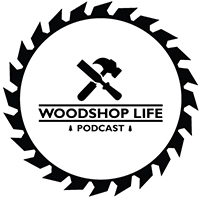This Episodes Listener Questions:
Guys Questions:
Hello Guy, Huy, and Brian,
Loving the content you guys are dishing out. Keep up the good work!
I have my sights set on a jointer in the near future as I would like to save time and energy squaring lumber. My preference up until now has generally been to buy new tools and the thought of refurbishing/repairing anything used has not appealed to me. However, the cost difference between a new/used jointer has me thinking differently. Also, the jointer seems to be one of, if not the easiest, of the big woodworking machines to refurbish given its simplicity. Correct me if I am wrong in this thinking. Curious to hear your thoughts if you think it is worth my time and effort to buy a used jointer or should I go new? What should I look for if I were to go used? I realize that moving a big machine like an 8″ jointer will be challenging, but I can easily get some friends together and rent a trailer to get the job done if the cost savings are great enough. Plus some beers and pizza for the helpers will help. Thanks! -John
Hey Folks,
Thank you for for the podcast. I love how quickly you jump right into the questions! Here’s mine: I’m building a set of screen doors for a cottage. The doors will be exposed directly to the weather in Quebec.
The doors will get a lot of abuse. They will close with a spring and slam frequently. The screen will run the full length of the door. I’m hoping to use a domino for the joinery.
3 questions: 1) what glue should I use? 2) what wood should I use? 3) How should I finish the doors?
Thanks ! Larry
Gentlemen,
First let me thank you for the podcast. I recently stumbled upon it and you three are now my regular company on my daily commute. Thank you! I consider myself a beginner hobbyist woodworker. My shop is the third bay of a 3 bay garage. My question is about when it is appropriate to use 3/4 inch vs 1/2 inch plywood. 3/4 inch plywood is so common, I wonder if it is needed as often as it is used? What kinds of applications need 3/4 inch plywood and what are some examples of when 1/2 inch plywood would be sufficient? I know that I am often guilty of over building projects and I suspect many woodworkers are. 🙂 Thanks for any information you can provide.
James Aydelotte
Huy’s Questions:
One more quick question, I’m working on getting into proper jointery. Is a nice hand saw worth investing in or is there an affordable option I can go with. I do mostly custom trim work but getting into more furniture grade work so it’s not something I will be using all day every day. Arntz Construction
Huy,
I am considering a clearvue and Oneida cyclone dust collector. I know you have the clearvue. What is your opinion of its performance? I have heard that it is very loud, what do you think? Thanks! Don
I’ve been doing more and more hand tool woodworking, so less and less dust-producing activities, but I still have occasion to use regular power tools for certain things. I’ve been striving to get better performance from my roll-around single stage D/C (with add-on cyclone pre-separator) and upgrading my hand-held power tools to ones with better built-in dust extraction… but there are still operations (edge cuts on the TS or with the router) that just spew crap everywhere. One area I need to probably do better on is wearing some sort of dust mask and/or respirator. I’ve avoided wearing them in the past, due to having a beard and knowing that masks get a very poor if any seal as a result. I’m considering getting something like a Trend AirShield (powered respirator / face shield), and was wondering if you have any other suggestions? Monte
